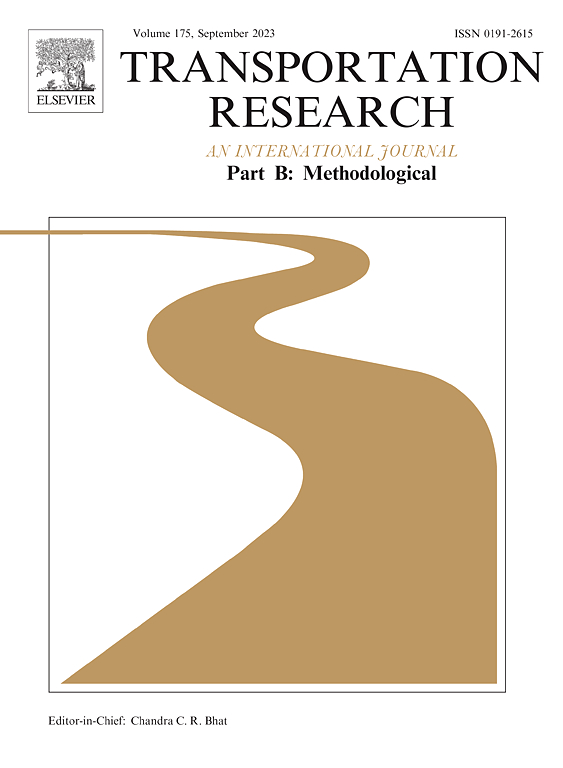Optimizing OD-based up-front discounting strategies for enroute ridepooling services
IF 5.8
1区 工程技术
Q1 ECONOMICS
引用次数: 0
Abstract
The technological progress in the recent decade has greatly facilitated the large-scale implementation of dynamic enroute ridepooling services, such as Uber Pool and DiDi Pinche. To sustain a profitable enroute ridepooling service, a well-designed discounting scheme is crucial. This paper focuses on the optimization of up-front discounting strategies for enroute ridepooling service, under which passengers are notified of origin–destination(OD)-based discount ratios together with estimated ride time before the start of their trips and enjoy the discounted prices no matter if they succeed or fail to get matched afterward. Assuming that ridepooling demand of each OD pair decreases with its price and the estimated waiting and ride time, we propose to optimize the discounting strategy of each OD pair through two methods. In the first method, the ridepooling price of each OD pair is optimized independently and adjusted day-to-day based on historical information; and in the second method, we optimize the prices of all OD pairs simultaneously, with the complex interactions among the expected ride and waiting times and the demand rates of all OD pairs being considered and captured by a system of nonlinear equations. The nonlinear and non-convex optimization problem of the second method is solved by two derivative-free algorithms: Bayesian optimization and classification-based optimization. Based on a 15*15 grid network with 30 OD pairs and the real road network of Haikou (China), we conduct simulation experiments to examine the efficiency of the two algorithms and the system performance under different discounting strategies derived from the two methods. It is found that in comparison with a uniform discounting strategy, OD-based discounting strategies generated by both methods can bring about 3.84% more profit to the platform. In comparison with the independently optimized discounting strategies generated by the first method, the system optimal discounting strategy generated by the second method can further improve the platform profit by 5.55% and 2.71% on average in our grid-network and real road network experiments.
优化基于 OD 的途中乘车折扣策略
近十年来的技术进步极大地促进了动态途中拼车服务的大规模实施,如 Uber Pool 和 DiDi Pinche。要维持可盈利的途中拼车服务,精心设计的折扣方案至关重要。在这种情况下,乘客会在出行前收到基于出发地-目的地(OD)的折扣率和预计乘车时间的通知,并在出行后无论匹配成功与否都能享受折扣价。假设每对定向配对乘客的乘车需求随其价格和预计等待及乘车时间的增加而减少,我们建议通过两种方法优化每对定向配对乘客的折扣策略。在第一种方法中,每对 OD 的乘车价格都是独立优化的,并根据历史信息逐日调整;在第二种方法中,我们同时优化所有 OD 的价格,所有 OD 的预期乘车时间、等待时间和需求率之间的复杂相互作用都被考虑在内,并通过一个非线性方程系统加以捕捉。第二种方法的非线性和非凸优化问题由两种无导数算法解决:贝叶斯优化和基于分类的优化。我们基于一个 15*15 的网格网络(有 30 个 OD 对)和海口(中国)的实际道路网络,进行了仿真实验,检验了两种算法的效率以及由两种方法得出的不同折现策略下的系统性能。结果发现,与统一折扣策略相比,两种方法生成的基于 OD 的折扣策略可为平台带来约 3.84% 的利润。在网格网络和实际道路网络实验中,与第一种方法生成的独立优化贴现策略相比,第二种方法生成的系统最优贴现策略可进一步提高平台利润,平均提高 5.55% 和 2.71%。
本文章由计算机程序翻译,如有差异,请以英文原文为准。
求助全文
约1分钟内获得全文
求助全文
来源期刊
CiteScore
12.40
自引率
8.80%
发文量
143
审稿时长
14.1 weeks
期刊介绍:
Transportation Research: Part B publishes papers on all methodological aspects of the subject, particularly those that require mathematical analysis. The general theme of the journal is the development and solution of problems that are adequately motivated to deal with important aspects of the design and/or analysis of transportation systems. Areas covered include: traffic flow; design and analysis of transportation networks; control and scheduling; optimization; queuing theory; logistics; supply chains; development and application of statistical, econometric and mathematical models to address transportation problems; cost models; pricing and/or investment; traveler or shipper behavior; cost-benefit methodologies.

 求助内容:
求助内容: 应助结果提醒方式:
应助结果提醒方式:


